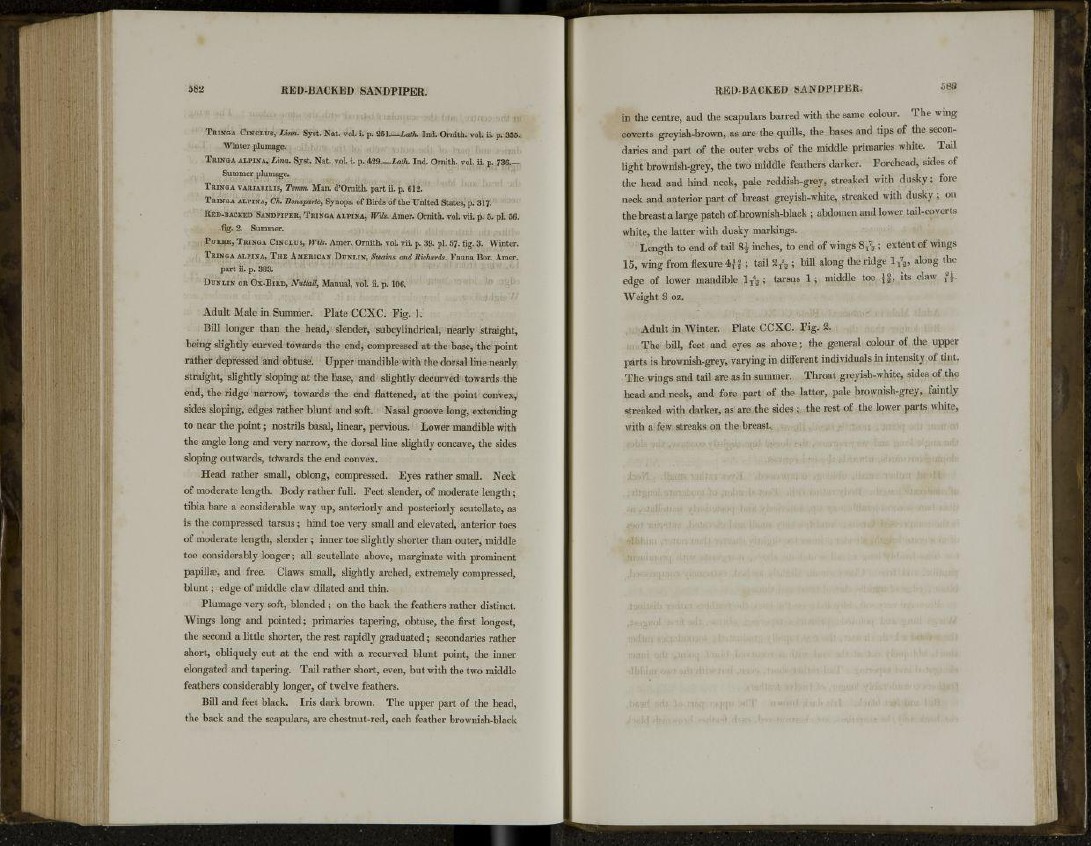
582 RED-BACKED SANDPIPER.
TRINGA CINCLUS, Linn. Syst. Nat. vol. i. p. 251—Lath. Ind. Ornith. vol. ii. p. 335.
Winter plumage.
TRINGA ALPINA, Linn. Syst. Nat. vol. i. p. 429—Lath. Ind. Ornith. vol. ii. p. 736.—
Summer plumage.
TRINGA VARIABILIS, Temm. Man. d'Ornith. part ii. p. 612.
TRINGA ALPINA, Ch. Bonaparte, Synops. of Birds of the United States, p. 317.
RED-BACKED SANDPIPER, TRINGA ALPINA, Wils. Amer. Ornith. vol. vii. p. 5. pL 56.
fig. 2. Summer.
PURRE, TRINGA CINCLUS, Wils. Amer. Ornith. vol. vii. p. 39. pi. 57. fig. 3. Winter.
TRINGA ALPINA, THE AMERICAN DUNLIN, Swains, and Richards. Fauna Bor. Amer.
part ii. p. 383.
DUNLIN OR OX-BIRD, Nuttall, Manual, vol. ii. p. 106.
Adult Male in Summer. Plate CCXC. Fig. 1.
Bill longer than the head, slender, subcylindrical, nearly straight,
being slightly curved towards the end, compressed at the base, the point
rather depressed and obtuse. Upper mandible with the dorsal line nearly
straight, slightly sloping at the base, and slightly decurved towards the
end, the ridge narrow, towards the end flattened, at the point convex,
sides sloping, edges rather blunt and soft. Nasal groove long, extending
to near the point; nostrils basal, linear, pervious. Lower mandible with
the angle long and very narrow, the dorsal line slightly concave, the sides
sloping outwards, tcfwards the end convex.
Head rather small, oblong, compressed. Eyes rather small. Neck
of moderate length. Body rather full. Feet slender, of moderate length;
tibia bare a considerable way up, anteriorly and posteriorly scutellate, as
is the compressed tarsus; hind toe very small and elevated, anterior toes
of moderate length, slender ; inner toe slightly shorter than outer, middle
toe considerably longer; all scutellate above, marginate with prominent
papillae, and free. Claws small, slightly arched, extremely compressed,
blunt; edge of middle claw dilated and thin.
Plumage very soft, blended ; on the back the feathers rather distinct.
Wings long and pointed; primaries tapering, obtuse, the first longest,
the second a little shorter, the rest rapidly graduated; secondaries rather
short, obliquely cut at the end with a recurved blunt point, the inner
elongated and tapering. Tail rather short, even, but with the two middle
feathers considerably longer, of twelve feathers.
Bill and feet black. Iris dark brown. The upper part of the head,
the back and the scapulars, are chestnut-red, each feather brownish-black
RED-BACKED SANDPIPER. 583
in the centre, aud the scapulars barred with the same colour. The wing
coverts greyish-brown, as are the quills, the bases and tips of the secondaries
and part of the outer webs of the middle primaries white. Tail
light brownish-grey, the two middle feathers darker. Forehead, sides of
the head and hind neck, pale reddish-grey, streaked with dusky; fore
neck and anterior part of breast greyish-white, streaked with dusky ; on
the breast a large patch of brownish-black ; abdomen and lower tail-coverts
white, the latter with dusky markings.
Length to end of tail 8^ inches, to end of wings 8ft ; extent of wings
15, wing from flexure ; tail 2 T
5
2 ; bill along the ridge 1 ^ , along the
edge of lower mandible 1T
6
2 ; tarsus 1; middle toe {§, its claw T
a£.
Weight 3 oz.
Adult in Winter. Plate CCXC. Fig. 2.
The bill, feet and eyes as above; the general colour of the upper
parts is brownish-grey, varying in different individuals in intensity of tint.
The wings and tail are as in summer. Throat greyish-white, sides of the
head and neck, and fore part of the latter, pale brownish-grey, faintly
streaked with darker, as are the sides ; the rest of the lower parts white,
with a few streaks on the breast.